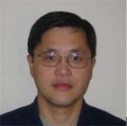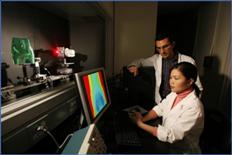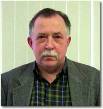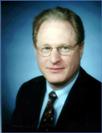Home > News and Events > NIBIB Newsletter 
In This Issue
LinksNational Institute of Biomedical Imaging and Bioengineering (www.nibib.nih.gov)National Institutes of Health (www.nih.gov) Contact Usnibibinfo@mail.nih.govNIBIB Fifth Anniversary CelebrationNIBIB Fifth Anniversary Celebrates Innovative Interdisciplinary ResearchThe last Astronaut to walk on the moon, a former U.S. Surgeon General, and a Nobel Prize winner were among those who helped NIBIB celebrate its fifth anniversary May 31 and June 1. The scientific program, “Changing the World’s Healthcare through Biomedical Technologies” at Lister Hill Center Auditorium, highlighted the critical role NIBIB plays in leading interdisciplinary research to develop innovative technologies that improve healthcare. The audience was welcomed and the day’s program was introduced by the current and first NIBIB Director, Roderic I. Pettigrew. The celebration began with a dinner the evening before the scientific program, sponsored by the Coalition for Imaging and Bioengineering Research, the American Institute for Medical and Biological Engineering, and the Academy of Radiology Research, at the JW Marriott, Washington DC, on Thursday, May 31. In the opening address, former U.S. Surgeon General David Satcher said, “Integrating bioimaging and bioengineering will be critical to research in the future and to the new medical paradigm.” Indeed, “NIBIB is at the forefront of a lot of what we must do to face the changing medical paradigm,” which includes an aging population, increasing diversity, and growing global interconnectedness, according to Satcher.  Harrison Schmitt and Roderic Pettigrew Former U.S. Senator and Apollo Astronaut Harrison Schmitt, the last man to have walked on the moon, gave the evening’s keynote address and described the synergies between space exploration and healthcare research. Schmitt, who chairs the NASA Advisory Council, envisioned an even stronger relationship between NASA and NIH. He described the “extraordinary science legacy” of the Apollo program and emphasized the importance of continuing to build a reservoir of young scientists, engineers, and other skilled workers. “We need another Sputnik generation, but one not just related to space exploration,” Schmitt said. He also provided a few lessons learned from the Apollo program, including what he defined as “the greatest mistake after Apollo.” “We made a big investment of tax dollars and then walked away,” he said. “We didn’t amortize our investment.” Future space exploration such as traveling to Mars will require improved understanding of biomedical issues facing humans such as muscle atrophy, bone loss, and immune system reactions. Schmitt urged more research on these and other biomedical issues because “compared to how we do medicine on earth, we are in the dark in space.”
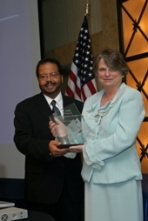 Roderic Pettigrew and Joan Dawson, wife of the late Paul Lauterbur The evening’s most poignant moment came when NIBIB Director Pettigrew presented the inaugural NIBIB Landmark Achievement Award to magnetic resonance imaging (MRI) pioneer Paul Lauterbur’s widow, Joan Dawson, who accepted the award on behalf of the Nobel Laureate. Lauterbur died in March. In accepting the award Dawson, who was visibly moved, said, “This is quite a singular moment for me. Paul was very grateful he would be receiving this award. Thank you.”
Emerging TechnologiesThe scientific program, “Changing the World’s Healthcare through Biomedical Technologies” was held at Lister Hill Center Auditorium on Friday, June 1. The program highlighted the increasing role NIBIB plays in fostering interdisciplinary research of innovative technologies that are improving healthcare today and into the future. NIH Director Elias Zerhouni outlined the critical role NIBIB plays in supporting emerging technologies to quantify and measure biological systems. “NIBIB is the missing piece that needed to exist to accelerate progress across biological disciplines in the 21st century,” Zerhouni said. He noted that NIBIB was created to provide a home for the discovery of new technologies, techniques, and approaches to solve the major challenges faced in the healthcare system today. Establishing the NIBIB was not easy, and both the bioengineering and biomedical imaging communities struggled to gain Congressional approval for formation of the Institute. Some of the key players who worked diligently to establish the Institute, C. Douglas Maynard of Wake Forest University School of Medicine, Shu Chien of the University of California, San Diego, Stanley Baum of the University of Pennsylvania School of Medicine, and Robert Nerem of the Georgia Institute of Technology, provided some of the history of the formation of the Institute. In addition, some of NIBIB’s unique achievements were highlighted, including the introduction of innovative policies and programs such as the Clinical Resident Research Supplement Awards, the Quantum Projects Initiative, and the Nagy New Investigator Awards. To celebrate the achievements of magnetic resonance imaging pioneer and Nobel Laureate Paul Lauterbur, Waldo Hinshaw, an MRI pioneer and an early colleague of Lauterbur’s, related the key role that Lauterbur played in creating the technology. Hinshaw described Lauterbur as both a conductor and mentor and noted that he was adept at gathering people to work on the new technology and fostering a fellowship among them. Lauterbur understood the importance of blurring the boundaries between disciplines, as evidenced by the title of his 2003 Nobel lecture, “All Science Is Interdisciplinary – From Magnetic Moments to Molecules to Men.” Lauterbur not only contributed to the science of magnetic resonance but served as its champion and advocate. “He was very good at convincing people that this was a technology that warranted attention,” Hinshaw said. Institute of Medicine President Harvey Fineberg opened his talk on “Healthcare Challenges in the 21st Century” with praise for NIBIB’s swift start: “This Institute has launched in such a remarkable way and opened up avenues for research that really didn’t exist.” After describing what he called the “healthcare predicament” that includes a failure to insure all Americans, rising costs of healthcare, deficient quality and safety, and workforce shortages, Fineberg noted that “NIBIB has every opportunity to make a huge difference in these areas and to resolve these needs.” Pursuing New Ideas Despite Opposition
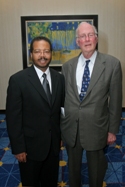 Roderic Pettigrew and Charles Townes Roderic Pettigrew and Charles TownesAs he refined the theory behind the Laser, Townes was told repeatedly that he was wasting money and should drop the project. Convinced his idea would work, Townes continued his research and was rewarded when graduate student James Gordon alerted him during a class that the Maser was working. Physics colleagues such as Nobel Laureates Niels Bohr and John von Neumann didn’t believe Townes was on the right track, though von Neumann finally acknowledged that a working Maser was possible. Even when he collaborated with his brother-in-law Arthur Schalow, a researcher at AT&T Bell Laboratories who thought the lab would benefit from the patent, AT&T patent lawyers initially balked because they doubted light could be useful for communications. Townes and Schalow wrote the patent themselves, noting how an optical Maser could be used in communications, and a patent was granted on behalf of Bell Labs in 1960. “There was no basic new idea in the Maser. All the physics was known before. You have to bring ideas together in the right way,” Townes said. He described different lasers and their applications and pointed out that he had not foreseen biomedical applications of the Laser. As he closed his talk he offered “best wishes to all of you as you continue to produce the future.” Displaying his own creativity and inventiveness, Ralph Weissleder, Director of the Center for Molecular Imaging Research, Massachusetts General Hospital, Harvard Medical School, gave attendees a look into the future of personalized medicine. Referring to NIBIB as the “clock that makes our lab tick,” Weissleder discussed an emerging optical imaging technique that uses near-infrared light to detect early lung cancers in animals. Because of its high spatial resolution and detection sensitivity, the technique “will have tremendous implications for biomedical research,” said Weissleder. In another technique, multiple biological processes are imaged simultaneously using nanoplatforms with multiple channels. Similar to a “lab on a chip,” Weissleder and his group have created nuclear magnetic resonance on a chip. “We can multiplex and phenotype rare cells in real time,” says Weissleder. “In less than a minute, we can profile blood.” The chip will be able to test for cancer and diabetes, and has the potential to be left in tumor beds and provide feedback on therapeutics. A key challenge facing researchers in the field of regenerative medicine is the inability to expand cells outside the body. Inadequate biomaterials and blood supplies have made it all but impossible to grow viable cells and cell networks. Over the last 5 years, Anthony Atala, Director of the Institute for Regenerative Medicine, Wake Forest University School of Medicine, has pioneered new methods to successfully grow cells outside the body. This body of work is a remarkable achievement and shows great promise for treating a wide array of diseases and disorders. His group has engineered many tissue types and some organs, including tracheas, vaginas, and bladders. Atala emphasized that his lab’s success is a result of a multidisciplinary approach that encompasses the work of some 400 researchers over 18 years. Interdisciplinary SuccessSuccessful endeavors in medicine and biology often benefit from input from other disciplines. While discussing the training of young scientists, Rensselaer Polytechnic Institute President Shirley Ann Jackson noted that NIBIB provides the critical linkage of the physical sciences with the biological sciences and highlights the promise of interdisciplinary work. She challenged the audience to “think more broadly about what interdisciplinary research means” and stressed the need to develop modeling techniques to study living systems in real time. “We are a long way from being able to model living systems. It will take intellects of many in different fields” to achieve this, she said. A panel of four young investigators described their paths to their current positions and noted the importance of NIBIB in filling the gap created by the closing of the Whitaker Foundation. “NIBIB stepped in and saved us from financial ruin,” panelist Joe Tien of Boston University explained, adding that “NIBIB is more willing to fund high-risk work than other sources of research support.” Work across disciplines has meant great progress for NIBIB’s first grantees, James Duncan and Dennis Spencer of Yale University. Their team approach, which combines physics, engineering, and clinical applications, has improved epilepsy surgery outcomes. In addition, their exciting work has created new techniques to map the brain’s electrical network during surgery and to investigate brain structure, function, and biochemistry. Establishing NIBIBThe birth of NIBIB, like many births, was not swift. In the late 1960s, a bill was introduced in Congress to establish a National Institute of Biomedical Engineering, but it went nowhere. The imaging research community lacked a unified voice and an advocacy group. In 1978, the Conjoint Committee on Diagnostic Radiology promoted an increase in Federal funding for radiological research. “This was the first effort at lobbying by the academic radiological community,” said Stanley Baum, University of Pennsylvania School of Medicine. The group was the forerunner to the Academy of Radiology Research (ARR), an alliance of 22 professional societies in radiology and imaging. The ARR was established in 1995 to increase support for imaging research and work toward establishing a new institute at NIH in this field. The mid- to late 1990s were a fertile time for cultivating support for an NIH institute dedicated to bioengineering and bioimaging. Then National Cancer Institute Director Richard Klausner was interested in imaging and wanted to explore how imaging could make an impact on research. Baum and past ARR President C. Douglas Maynard contacted Elias Zerhouni and other members of the ARR who, along with a group of engineers and scientists, developed a white paper on in vivo molecular and cellular imaging for Klausner. In addition, a congressionally requested study of bioengineering research at NIH led to the formation of the Bioengineering Consortium (BECON). The Consortium provided a focus for bioengineering at NIH and helped to prepare for the future of this emerging area. The final year of the Clinton Administration was pivotal in NIBIB’s creation. Now strong and speaking with a single voice, the bioengineering community, through ARR and the American Institute for Medical and Biological Engineering (AIMBE), intensified their efforts and through letter-writing campaigns, face-to-face meetings with House and Senate members, and testimony on the Hill, were able to get both chambers to pass a bill creating NIBIB by the end of 2000. The President signed the bill into law on December 29, 2000. The transition to a fully operational institute would take another year. NIBIB received its first budget appropriation in February 2002. The tenacity of several individuals meant success in the quest for an institute dedicated to biomedical imaging and bioengineering. Former ARR Executive Director Edward Nagy, who died unexpectedly in 2006, “was the driving force,” in getting NIBIB established, said Baum. Other individuals who played integral roles in the establishment of NIBIB were C. Douglas Maynard, Shu Chien, Stanley Baum, Robert Nerem, Charles Putnam, Nick Bryan, and Leonard Holman. “We wouldn’t be here if it weren’t for the role of the giants that preceded us,” commented AIMBE President and National Academy of Engineering member John Watson. Science Highlights
Of Mice and Microscopy: Promising Insights for Alzheimer's ResearchTwo of the holy grails of Alzheimer's disease research are early diagnosis and drug therapies to modify the disease outcome. Achieving these goals would dramatically alter the current state of treating this progressive, degenerative disorder that attacks the brain's nerve cells, or neurons, and robs individuals of their memory and ability to reason, communicate, and carry out daily activities. Today, the only way to diagnose the disease definitively is through an autopsy. What researchers do know is that two types of abnormal lesions clog the brains of individuals with Alzheimer's disease: beta-amyloid plaques-sticky clumps of protein fragments and cellular material that form outside and around neurons; and neurofibrillary tangles-insoluble twisted fibers composed largely of the protein tau that build up inside nerve cells. To shed light on how the disease begins and the path it takes, researchers at Massachusetts General Hospital in Boston have combined mouse models, an existing optical imaging technology - multiphoton microscopy (MPM) - and unique visualization agents. Their work provides an important step in evaluating Alzheimer's progression, hastening the discovery of beneficial drugs to treat the disease and change its course. "We have a limited understanding of the disease's progression," says Brian Bacskai, Associate Professor of Neurology at Massachusetts General Hospital in Boston. "Multiphoton microscopy allows us to see what's happening as the mouse gets sick and to potentially provide therapeutic interventions." To learn more about the work of Dr. Bacskai and other NIBIB grantees, please visit www.nibib.nih.gov/HealthEdu/eAdvances. Funding Opportunities & UpdatesNIBIB Residency Supplement ProgramTwo updated announcements extending the NIBIB Residency Supplement Program were recently published.
NIH Roadmap for Medical ResearchThe NIH Roadmap is a series of far-reaching initiatives designed to build on the progress in medical research achieved through the doubling of the NIH budget. NIBIB plays a significant role in Roadmap activities in many areas. More information on current NIH Roadmap funding opportunities is available at nihroadmap.nih.gov/grants/index.asp. NIH Blueprint for Neuroscience ResearchThe NIH Blueprint for Neuroscience Research is a cooperative effort among the 16 NIH Institutes, Centers, and Offices that support neuroscience research. By pooling resources and expertise, the Blueprint supports the development of new tools, training opportunities, and other resources to assist neuroscientists in both basic and clinical research. More information on current NIH Blueprint funding opportunities is available at neuroscienceblueprint.nih.gov/blueprint_funding/index.htm. Names in the NewsNew Faces at NIBIBAlisa Downing has joined the Office of Operational Management.Rossalyn Hart has joined the Office of the Director. Hilary Whitfield has joined the Office of Extramural Science Programs. Matt Wise has joined the Office of Operational Management, Information Technology. AwardsNIBIB Staff
At a recent Grants Management awards ceremony, the NIH Vision Steering Committee presented the following awards to members of the NIBIB Office of Grants Management:
The joint NIBIB/CDRH Laboratory for the Assessment of Medical Imaging Systems recently won the Food and Drug Administration Commissioner’s Award. Grantees
Chunlei Liu, Ph.D., of Stanford University was named one of three finalists for the I.I. Rabi Basic Science “Young Investigator Award” at the International Society for Magnetic Resonance in Medicine meeting recently held in Berlin, Germany. The award is given for original basic research in magnetic resonance and named after Isidor Isaac Rabi, the 1944 Nobel Prize winner for Physics. Dr. Liu was selected for the reorganization of his design of a novel algorithm for fast magnetic resonance imaging.
Vladimir Torchilin, Ph.D., D.Sc., of Northeastern University has received the 2007 Lifetime Research Achievement Award from the Pharmaceutical Sciences World Congress. Dr. Torchilin was recognized for his research in drug targeting, delivery systems, and nanomedicine, having secured more than 45 patents and published more than 300 papers, reviews, and book chapters, along with eight books. Conferences & MeetingsUpcoming Meetings and ExhibitionsThe National Advisory Council for Biomedical Imaging and Bioengineering NIBIB Grantsmanship Workshop 2007 BMES Annual Fall Meeting Society for the Advancement of Chicanos and Native Americans in Science (SACNAS) Annual Biomedical Research Conference for Minority Students (ABRCMS) Radiological Society of North America (RSNA) 2007 The NIH CornerNIH Director’s Bridge AwardNIH Director Elias A. Zerhouni, M.D., has announced a new program designed to provide one year of continued funding to permit new and established principal investigators additional time to strengthen resubmission applications. The program will be available to grantees who have submitted a competing renewal grant application that describes a highly meritorious project, but has fallen below the payline. To be eligible for this continued funding, the applicant must be within 10 percentage points of an Institute or Center’s payline, have less than $200,000 in other support (total costs), and be nominated by the Institute or Center with primary assignment. Additional information is available at grants.nih.gov/grants/guide/notice-files/NOT-OD-07-056.html.
In Memoriam—Stephen E. Straus, M.D.Stephen E. Straus, M.D., the first Director of the National Center for Complementary and Alternative Medicine (NCCAM) at the National Institutes of Health, died of brain cancer on May 14, 2007. He was 60.Read more about Dr. Straus at nccam.nih.gov/news/2007/051507.htm. |
 |
 |
Department of Health and Human Services |
 |
National Institutes of Health |
 |






